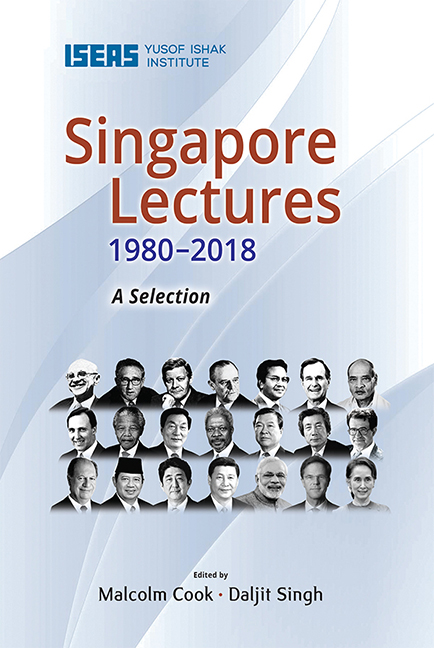Book contents
- Frontmatter
- Contents
- Introduction
- 1 The Invisible Hand in Economics and Politics
- 2 American Foreign Policy: A Global View
- 3 The Soviet Union: Challenges and Responses as Seen from the European Point of View
- 4 Trends in the International Financial System
- 5 Regionalism, Globalism and Spheres of Influence: ASEAN and the Challenge of Change into the 21st Century
- 6 US Policy in the Asia-Pacific Region: Meeting the Challenges of the Post-Cold War Era
- 7 India and the Asia-Pacific: Forging a New Relationship
- 8 Australia, Asia and the New Regionalism
- 9 South and Southern Africa into the Next Century
- 10 China and Asia in the New Century
- 11 Global Values: The United Nations and the Rule of Law in the 21st Century
- 12 Peace on the Korean Peninsula and East Asia
- 13 Japan and ASEAN in East Asia: A Sincere and Open Partnership
- 14 EU and Asia: Sharing Diversity in an Inter-regional Partnership
- 15 Global Challenges in the 21st Century: A View from Chile
- 16 Indonesia: The Challenge of Change
- 17 Japan and ASEAN, Always in Tandem: Towards a More Advantageous Win-Win Relationship through My “Three Arrows”
- 18 Forging a Strong Partnership to Enhance Prosperity of Asia
- 19 India’s Singapore Story
- 20 The Netherlands, Singapore, Our Regions, Our World: Connecting Our Common Future
- 21 Democratic Transition in Myanmar: Challenges and the Way Forward
- The Singapore Lecture Series
- The Editors
Introduction
Published online by Cambridge University Press: 09 October 2021
- Frontmatter
- Contents
- Introduction
- 1 The Invisible Hand in Economics and Politics
- 2 American Foreign Policy: A Global View
- 3 The Soviet Union: Challenges and Responses as Seen from the European Point of View
- 4 Trends in the International Financial System
- 5 Regionalism, Globalism and Spheres of Influence: ASEAN and the Challenge of Change into the 21st Century
- 6 US Policy in the Asia-Pacific Region: Meeting the Challenges of the Post-Cold War Era
- 7 India and the Asia-Pacific: Forging a New Relationship
- 8 Australia, Asia and the New Regionalism
- 9 South and Southern Africa into the Next Century
- 10 China and Asia in the New Century
- 11 Global Values: The United Nations and the Rule of Law in the 21st Century
- 12 Peace on the Korean Peninsula and East Asia
- 13 Japan and ASEAN in East Asia: A Sincere and Open Partnership
- 14 EU and Asia: Sharing Diversity in an Inter-regional Partnership
- 15 Global Challenges in the 21st Century: A View from Chile
- 16 Indonesia: The Challenge of Change
- 17 Japan and ASEAN, Always in Tandem: Towards a More Advantageous Win-Win Relationship through My “Three Arrows”
- 18 Forging a Strong Partnership to Enhance Prosperity of Asia
- 19 India’s Singapore Story
- 20 The Netherlands, Singapore, Our Regions, Our World: Connecting Our Common Future
- 21 Democratic Transition in Myanmar: Challenges and the Way Forward
- The Singapore Lecture Series
- The Editors
Summary
On 14 October 1980, the Institute of Southeast Asian Studies (ISEAS) hosted the inaugural Singapore Lecture given by Professor Milton Friedman to a packed audience at the Singapore Conference Hall. The First Deputy Prime Minister and Chairman of the Monetary Authority of Singapore Dr Goh Keng Swee chaired the lecture. The Monetary Authority of Singapore provided an endowment to ISEAS for the Singapore Lecture Series that year that was augmented three years later by a donation from Mobil Oil Singapore. Since then, the lectures have been co-funded by the Ministry of Foreign Affairs and ISEAS. The lectures usually are chaired by the Prime Minister or a Senior Cabinet member to reflect their purpose and status.
At that time, it was unlikely that ISEAS or the Singapore government realized how important a platform this lecture series would become for senior foreign experts and leaders to share their views on regional and global developments with a particular focus on their country or institution and Singapore. The lectures, spanning over almost four decades, have addressed the most important economic and strategic changes Singapore and Southeast Asia have had to respond to. These include the East-West confrontation of the Cold War, the end of the Cold War, the re-emergence of China as Asia's leading power, India's resurgence, ASEAN centrality, global financial turmoil, globalization and its drawbacks and the threat of global terrorism.
By the end of August 2018, ISEAS, by then renamed ISEAS – Yusof Ishak Institute, has had the honour of hosting forty-four Singapore Lectures. A complete list is available at the end of this volume. Prime Minister of Australia Bob Hawke was the first serving political leader to deliver a Singapore Lecture, the 8th lecture delivered in November 1987. A year later Prime Minister Mahathir Mohamad of Malaysia became the first leader from Asia to give a Singapore Lecture.
The roster of eminent persons who have accepted the invitation to give a Singapore Lecture is truly global in scope. Speakers have come from all parts of Asia, from Africa, South America, Oceania, Europe, North America and NATO and the United Nations. Befitting Singapore's location, seventeen Singapore Lectures have been delivered by serving political leaders from Asia, including the 44th Singapore Lecture by Li Keqiang, the premier of the People's Republic of China.
- Type
- Chapter
- Information
- Singapore Lectures 1980-2018 , pp. vii - viiiPublisher: ISEAS–Yusof Ishak InstitutePrint publication year: 2020

